It’s actually not that different from our current reality. The year is 2064 instead of 2015 and the protagonist (henceforth referred to as: you) lives in a tiny, ramshackle apartment. After composing a review on some fancy wireless headphones which you tested “thoroughly” (aka: for like three minutes) you settle into bed. But, almost like a scene from a horror film, something enters the apartment late at night. It’s dark, and when you finally come to you discover it’s a tiny, cute blue and white ROM (or, a super intelligent robot) named Turing. Turing alerts you to some troubling news – your successful AI-programming friend has been kidnapped. With no one else to turn to, Turing enlists you in the search. As with any good cyberpunk thriller, something larger is at play – but what?
That’s how the Read Only Memories demo begins and it provides an excellent jumping off point. We know what’s up and simply need to explore Neo SF for information. Folks are likely to notice the game’s unique presentation immediately. It’s not the fact that it utilizes pixel art, but the fact that only about 2/3rds of the screen are devoted to actual visuals that is unique. If you were a fan of adventure games when Hideo Kojima’s Snatcher launched in Japan then it’ll be a welcome sight. I’ve never had the pleasure of playing Kojima’s masterpiece, but I did play a fair share of MacVentures back in the day. They shared a similar “compact” game screen. While they did so out of necessity, it proves an excellent stylistic choice here.
Ranging from around half an hour to an hour depending on how far you allow yourself to get immersed in the world, the Read Only Memories demo leaves little to the imagination as far as actual play is concerned. Players utilize a point and click interface on each static screen. See something light up when you mouse over it? Click and choose an option from the radial menu (take, talk, etc). If there’s a person or ROM hanging about try chatting them up as well. The demo itself leaves much to be desired in regards to puzzles, but chances are most are locked up in later gameplay segments. Most of the experience provided thus far is one of looking at everything, talking to everyone, and enjoying the story slowly unravel.
My favorite aspect of Read Only Memories so far is its focus on diversity. Once you’re finally introduced to Turing the little bot asks you a series of questions: What name do you go by? Preferred pronouns? Heck, even what kind of foods you eat. Although I play it very dull, naming myself “Marcus” and going by “he,” it is powerful enough knowing that option even exists. I can’t even imagine how impressive this could be to folks who have never had such options presented to them in a game context before. The game’s world is similarly diverse. In this small sampling I saw a handful of NPCs who all bring something different to the table. The one thing I did notice was a lack of body diversity among apparent “main characters” but it’s too early to say for sure.
Cyberpunk futuristic cities seem a perfect avenue to explore diversity, and I am glad Midboss Games pursued it. Games that pretend that the world is all one way are simply steeped heavily in an improbable fantasy. In any case, I can’t pretend that none of my appreciation for Read Only Memories is due to that fact. Even so, the classic point and click adventure gameplay transports me to another time. Through playing I’m thrown back to concepts of “the future” permeated by 80s media. Paired with retro-inspired gameplay the entire experience is a bit of a trip – and a good one. I am immensely excited to get my hands on the complete version. Read Only Memories launches on August 18th for PC (Windows, Mac, Linux) and Ouya.





